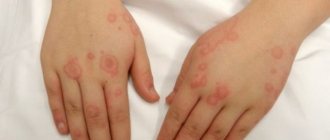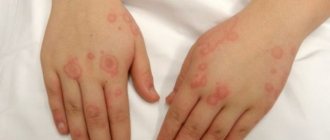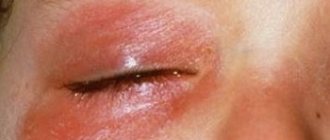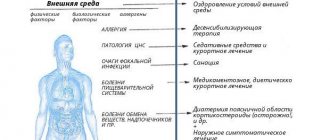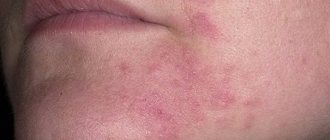Why does my left hand hurt?
If your hand hurts, then most likely the first thing you will think is that you have somehow damaged it. But, in fact, pain in one part of the body can at times signal problems with other organs or structures in our body.
Keep reading to learn more about the causes of left arm pain and the symptoms that indicate a serious problem.
Possible causes of pain in the left arm
There are many causes of pain in the left hand, including complications of arthrosis and other chronic diseases.
1) Herniated disc of the cervical spine
Cervical disc herniation is the most common cause of pain in the left arm that lasts more than 1 week. The reason for the pain in the arm is that the intervertebral disc that has entered the spinal canal pinches the root of the spinal cord, from which the nerves supplying the shoulder, arm and scapula depart.
Pain from a herniated disc can radiate to the shoulder, arm, hand, or even fingers. You may also feel numbness, tingling, or burning in your arm. The pain may worsen when you move your arm.
The pain is most often one-sided. It is rarely isolated, most often pain in the arm is combined with symptoms such as headaches, dizziness, surges in blood pressure, pain in the neck, shoulder, and numbness in the fingers.
If, in addition to pain in your left arm, you experience at least one of the listed symptoms, then you need to do an MRI of the cervical spine using a high-field machine and consult a doctor.
2) Myocardial infarction
Pain in the left arm may be a symptom of myocardial infarction.
A blood clot or rupture in a coronary artery can stop blood flow to part of the heart. When this happens, the muscle can quickly become damaged. Without treatment, the heart muscle begins to die.
Read also…. Ways to block back and joint pain
Additional heart attack symptoms include:
- chest pain or pressure;
- back, neck, shoulder, or jaw pain;
- nausea or vomiting;
- shortness of breath;
- feeling lightheaded or fainting;
- cold sweat;
- fatigue.
- fear of death
During a heart attack, some people experience severe symptoms. Others experience symptoms that go away on their own or may be completely minor, such as indigestion.
3) Angina pectoris
Angina pectoris is a symptom of coronary heart disease. This symptom means that the heart muscles are not receiving enough oxygenated blood.
Angina occurs in the same way as a heart attack, but usually lasts only a few minutes. It usually increases with active movements and decreases during rest.
4) Bursitis
A bursa is a fluid-filled sac located between bone and the moving parts of a joint.
Inflammation of the bursa is called bursitis. Shoulder bursitis is often the result of repetitive movements. The risk of developing bursitis increases with age.
The pain usually gets worse when you move or lie on your arm or shoulder. Rotation of the shoulder can cause an onset of pain. Other symptoms include burning and tingling.
5) Bone fracture
In some cases, a broken arm or wrist is not accompanied by any other symptoms other than, of course, pain.
A broken bone in the arm, wrist, or hand can cause pain that gets worse with movement. Other symptoms may include swelling and numbness. Sometimes when a bone in your hand or wrist is broken, your hand may look completely normal.
6) Nerve compression or cervical radiculopathy
Nerve compression is when a nerve is pinched or inflamed. The cause of nerve compression is not only a herniated disc, but also other complications of osteochondrosis - spondylosis, spondyloarthrosis, secondary spinal canal stenosis.
With spondylosis, the formation of bone growths (osteophytes) occurs, which can also compress the roots of the spinal cord. Also, osteophytes can cause secondary stenosis of the spinal canal, which significantly aggravates the course of all other complications of spinal osteochondrosis, while at the same time the stenosis itself can cause pain.
Symptoms of nerve root compression are identical to those of a herniated disc and may include numbness, tingling, or burning in the arm. Symptoms of cervical radiculopathy may also worsen with movement.
7) Rotator cuff tear
Lifting a heavy object or performing repetitive movements can tear the tendon in the rotator cuff. This significantly weakens the shoulder and makes it difficult to perform most normal activities.
When a rotator cuff injury occurs, it is painful for the patient to lie on his side. In addition, pain in the arm may increase with certain movements. This injury can result in significant weakening of the arm. The range of motion of the shoulder is also reduced.
Read also…. Headache in the back of the head
 Sprained ligaments, muscles and tendons
Sprained ligaments, muscles and tendons
A sprained ligament occurs as a result of overexertion or injury. A sprained ligament can occur from a sudden fall or during active sports games. A muscle or tendon strain can occur when you twist or pull a tendon or muscle. The causes of a muscle or tendon strain may be improper lifting of a heavy object or overstrain of the muscle when holding a forced position for a long time.
Hematoma, swelling and weakness are common additional symptoms of a sprain.
9) Tendonitis
Ligaments are bundles of elastic tissue that connect bones to muscles. Inflammation of the ligaments is called tendinitis. Tendonitis in the shoulder or elbow can lead to arm pain. The risk of tendonitis increases with age.
Symptoms of tendinitis are identical to those of bursitis
10) Vascular syndrome of the scalene muscle
Vascular scalene syndrome is a condition in which the blood vessels under the collarbone become compressed due to injury or repeated damage. If left untreated, this syndrome can cause progressive nerve damage.
Vascular scalene syndrome can cause numbness, tingling, and weakness in the arm. In some cases, swelling of the arm may occur.
Other signs include a pale and cold hand and a weakened pulse in the hand.
Burning sensation in forearm
Burning pain, as a rule, indicates aseptic tendovaginitis. This inflammatory disease of connective tissue is not associated with infection, but with prolonged monotonous physical activity (usually an occupational disease). Pain syndrome with aseptic tendovaginitis is usually accompanied by pain in the fingers.
Another cause of pain may be gout.
With this disease, uric acid salts (urates) are deposited in the joints (elbow, wrist). The result is a burning pain in the joints that spreads to the forearm. The pain syndrome may be accompanied by the formation of subcutaneous lumps (tophi) on the inside of the forearm. What to do if your forearm hurts, or you have found signs of at least one of the syndromes listed above? All these diseases are successfully treated using the comprehensive use of oriental medicine methods at the Tibet clinic in Moscow and St. Petersburg. The clinic has been operating for more than 10 years. As a result, the pain syndrome disappears, the range of arm movements and physical performance are restored, and disease complications are prevented.
Diagnostics
If you are suffering from pain in your left arm, accompanied by other signs of a heart attack, then do not hesitate. Call an ambulance. A heart attack can be life-threatening.
Emergency workers will use an electrocardiogram (ECG) to monitor your heart's function. The patient will also have an intravenous catheter placed so that they can provide you with fluids and medications if necessary. Some patients may also need oxygen therapy.
Other diagnostic tests will help determine whether there has been a heart attack. Treatment depends on the extent of the damage.
Other causes of left arm pain may require imaging tests. These tests may include x-rays, computed tomography (CT), and magnetic resonance imaging (MRI).
Further testing depends on your symptoms and the results of previous tests.
If you suspect osteochondrosis of the cervical spine and its complications, it is necessary to do an MRI of the cervical spine using a high-field machine. You should not start with an X-ray of the spine, since with this pathology this is a low-informative study and the dose of radiation you will receive in vain.
Treatment of pain in the left hand
If you suffer from heart disease, treatment may include medications and lifestyle changes. If you have severe heart disease, you may need surgery to clear or bypass blocked arteries.
Read also…. Neuropathic pain
In case of a fracture, the bones will be returned to their natural position and fixed. Typically, the broken bone is fixed in a cast, which must be worn for several weeks. Serious fractures sometimes require surgery.
When spraining muscles, ligaments and tendons, it is recommended to keep your arm in an elevated position. Apply ice several times a day. An elastic bandage may be needed to secure the sprain.
In the treatment of disc herniation and other complications of osteochondrosis, non-stress spinal traction, therapeutic exercises, various types of massage, and hirudotherapy are used. Contrary to popular belief, a herniated disc can be treated with comprehensive treatment and may even decrease significantly in size.
Physiotherapy, rest and medication may be the main treatment for:
- bursitis;
- rotator cuff tear;
- tendinitis;
- vascular syndrome of the scalene muscle.
In some cases, patients may require surgery or treatment with corticosteroids.
Why do my palms and soles burn?
Many patients complain that their feet are burning without an objective reason.
As a rule, this symptom is not an independent disease, but indicates a number of pathologies and diseases. Moreover, some of them are directly connected to the lower extremities, while the rest are a sign of internal systemic disorders. By accurately establishing the cause of burning feet, you can find the right direction of therapy and ensure the patient a speedy recovery.
Lower limb problems
There are a number of situations when burning in the legs appears from time to time and goes away on its own:
- fatigue after long periods of walking or running;
- lack of vitamins (especially group B);
- hereditary disposition (rare);
- uneven overload on the lower extremities caused by an old injury, recent surgery in the area, incorrectly healed fractures, sprains, tissue ruptures, etc.;
- discomfort after directed overload to an area (for example, squats or lunges with weight);
- individual reaction to changes in pressure or weather (legs and feet “twist”);
- tight and awkward shoes (often your feet burn in the latest shoes or those with the wrong size);
- injuries after long-term walking with bare feet (corns, calluses, cracks);
- microtraumas of the feet (wounds, cuts, punctures, ulcers, burns, frostbite, etc.), as well as infection.
Diagnosis in this case involves interviewing the patient (the conditions and time when the symptom occurred) and a visual examination.
In case of old or recent injuries, uneven overload or deformation of the foot, the therapist sends the patient to an orthopedist or doctor.
If the doctor suspects an infectious lesion, then a general blood test (sometimes urine) is prescribed to identify pathogenic microflora.
Systemic diseases
If burning in the legs is not the only symptom and causes discomfort for a long time, a number of systemic diseases must be excluded.
Allergy
Most often, burning is a local reaction of the feet to the insoles used for the production of shoes.
Allergies can also be to stockings, tights, socks and slippers, cosmetic care products (depilatory cream, body milk, foot deodorant, etc.). To exclude allergies, a general blood test and allergy tests are prescribed.
Endarteritis obliterans
Vascular pathology intertwined with dysfunction of the autonomic nervous system. It can be caused by stress, psychological and nervous disorders, and infections. The affected leg artery has poor supply of blood with oxygen and nutrients, which leads to a number of symptoms: numbness and swelling of the tissues, burning and tingling sensations, recurring pain, redness, etc.
The patient is referred for examination and consultation with a phlebologist and neurologist.
They will prescribe the necessary diagnostic tests according to their own specialization (coagulogram, multifunctional tests, ultrasound, angiography, capillaroscopy, etc.).
Varicose veins of the lower extremities
A common reason why women's feet burn. The pathology is associated with an abnormal increase in the size of the superficial veins of the legs. The disease is accompanied by muscle cramps, burning in the calves and feet in the late evening, swelling of the tissues, lethargy of the legs and other symptoms.
The diagnosis of the disease is carried out by a phlebologist, prescribing studies (duplex sonography, VMR, CT phlebography, etc.).
Mycosis of the feet
Foot fungus occurs after visiting public places (sauna, swimming pool, beach), as well as as a result of excessive moisture in shoes (foot hyperhidrosis, getting wet in rainy weather, etc.).
A burning sensation, itching and peeling begins in the area of the interdigital folds, then the fungus invades the surface of the feet and nails, leading to a change in their color.
If a fungus is suspected, the therapist refers the patient to a mycologist, who prescribes tests and studies (for example, culture).
Diabetes
Surprisingly, one of the earliest signs of diabetes is a feeling of “burning legs.” High levels of sugar lead to damage to the capillaries, which leads to their spasms and pain.
An endocrinologist diagnoses diabetes based on a glucose tolerance test, blood and urine tests, etc.
Vegetative-vascular dystonia
A burning sensation in the feet is associated with disorders of the central nervous system for various reasons (chronic lethargy and lack of sleep, stress, bad habits, abuse of strong coffee and tea, genetic predisposition, physical inactivity, vascular and heart diseases, endocrine disorders, etc.). Along with the burning sensation, the patient can observe changes in the temperature of the surface of the feet (they become either hot or icy).
Making a diagnosis requires consultation with a neurologist, cardiologist and endocrinologist.
EEG and ECG of the brain, multifunctional tests are also prescribed.
Pregnancy
Another reason why a woman’s feet may burn. In the later stages, expectant mothers complain of numbness and burning of the feet, which can be associated with a complication of pregnancy - gestosis.
Late toxicosis is also accompanied by high blood pressure and swelling of the lower extremities, which causes the calves and feet to practically “burn.”
Pathology can also be caused by extra pounds gained during pregnancy.
Physiotherapy
You can eliminate or alleviate the symptom using physiotherapeutic methods and procedures:
- A contrast shower with cool and warm water will help relieve heaviness in the legs and remove the tingling feeling, “cool” the surface of the feet. The duration of the procedure is 20 minutes a day. After manipulation, moisten the area with cooling cream with menthol.
- To restore blood flow from the legs and relieve tingling, you need to lie in the “legs above head” position and remain there for minutes. At the same time, it would be great if a relative would apply the cooling cream in the direction from the fingers up to the knee.
- You can remove the burning sensation by alternately bending your toes. You can also twist your feet clockwise and counterclockwise - blood circulation will improve and the feeling of lethargy will go away.
- Massage your foot - rub it in the direction from the phalanges to the heel. Stretch and stretch each finger. You can also use wood massagers.
- Place small pebbles (preferably sea pebbles), buckwheat or peas on the floor or a special rug and trample with your bare feet for minutes.
- Try to cool your feet more often with cold baths or compresses. Soaring your feet and using a heating pad is strictly prohibited.
- Sign up for physiotherapy procedures: magnetic therapy, electrophoresis, paraffin-ozokerite applications on the feet, etc.
Treatment with medications and traditional recipes
- An allergic reaction to shoes or tights can be eliminated with the help of antihistamines: Flucinara and Celestoderma.
- Burning sensations due to sprains, old injuries, stress and lethargy are relieved by medications for arthrosis and osteochondrosis.
- Mycosis of the feet should be treated with antifungal ointments: Miconazole, Nystatin, Clotrimazole, etc. In the acute form, antifungal drugs are also taken orally.
- For neuralgia and lesions of the autonomic and central nervous system, it is targeted to take anticonvulsants (Gabapentin), antioxidants, antidepressants (Desipramine), and anti-inflammatory non-steroidal drugs (Ibuprofen).
- If the body does not have enough vitamin B, its level can be increased with the help of a special protein diet, as well as complex medications (Neurobion, B and others).
- For sweet diabetes, it is targeted to take biguanides, sulfonylureas, meglitinides to eliminate burning feet.
- For the treatment of endarteritis, complex treatment is used with antihistamines (Suprastin), gangioblockers (Geksonium), painkillers (No-spa) and products that increase blood rheology (ascorbic and nicotinic acids).
- Varicose veins are treated with venotonics (Venarus), capillary-stabilizing drugs, anti-inflammatory analgesics and antihypoxants. To treat thrombophlebitis, fibrinolytics (Urokinase) and anticoagulants (Heparin) are additionally prescribed.
As for folk recipes, if your feet are burning, it is best to use the following:
- Herbal bath. The collection of wormwood, hops, chamomile and marigold is used. Take 2 spoons of the mixture and pour a liter of boiling water. Cool the broth to room temperature and soak your feet in it for half an hour.
- Applications with blue clay. Apply the softened mass to the feet, cover tightly with cling film and leave for 2 hours. After this, the product should be washed off and moisturize your feet with a cooling gel. The wrap should be done every 3 days.
- Horse chestnut drink. Take 2 spoons of the mixture and pour ml of boiling water. Leave for 30 minutes, after which you should drink the decoction moderately throughout the day. The prepared pharmaceutical tincture should be drunk three times a day, 20 drops on an empty stomach.
- Alcohol compress. Combine ml of honey alcohol with 2 tablespoons of olive oil. Rub the purchased product over the burning area and cover with cling film for 30 minutes.
- Lemon lotion. Wipe your burning feet with lemon zest or juice, after a while take a cold foot bath and let your feet breathe without slippers, shoes or socks.
Prevention of burning feet
First of all, look at what kind of shoes you buy. It must strictly correspond to the size (including not be too big), be well ventilated, and have a stable last (sole).
It is extremely good if environmentally friendly and natural materials were used in the production of the product. At home, try to walk barefoot more often and beware of closed slippers, woolen socks, etc. Remember to frequently air and dry your shoes after a walk, especially if liquid has gotten into them.
Monitor the condition of your blood vessels, for which you need to moderately load both legs and monitor your well-being during sports.
It is necessary to adhere to a diet that is correct for blood vessels, which excludes alcoholic and strong drinks, spices, spicy and very sour foods, sweet gas-water and cholesterol.
These products contribute to the development of ODA and also disrupt blood flow in the veins.
A contrast shower for your feet after a long walk will be a good prevention of not only burning feet, but also fungus, neuralgia, and vascular pathologies.
Repeated baths for tired legs with sea salt, menthol or eucalyptus essential oil, and a decoction of medicinal herbs are also useful.
Before going to bed, massage your feet with a moisturizing or cooling cream, which will help restore blood flow to the area.
And, of course, maintain regular foot hygiene!
To avoid pathologies, be attentive to your own health. If you experience the first signs of lethargy and discomfort in your legs, consult your doctor.
Source: //allergich.com/profilaktika/pochemu-goryat-ladoni-i-stupni-nog.html
What to do if your left hand hurts?
A heart attack can occur suddenly or develop gradually. Either way, the most common symptom of a heart attack is chest discomfort or pain. If you think you may be having a heart attack, call an ambulance immediately. If it comes to damage to the heart muscle, then every second will count.
Also keep in mind that:
- If you have been diagnosed with heart disease, then pain in your left arm should always be a cause for concern;
- improperly fused bone can cause many problems. If you think you have a fracture, consult a doctor immediately;
- Without treatment, bursitis, tendinitis and rotator cuff tears can lead to complications such as frozen shoulder, which are much more difficult to treat. If you cannot fully rotate your shoulder, elbow or wrist, consult a doctor;
- If you strain a muscle, ligament, or tendon, rest your arm and try to keep it elevated. Apply cold for 20 minutes several times a day. Use non-steroidal anti-inflammatory drugs.
Although some of the above conditions are not serious, they can become serious without proper treatment. Call your doctor if home treatments don't help or if the situation gets worse.
Why do hands burn according to folk signs?
> Hands >
If your hands are burning, you should take this as a warning, since body language can warn of impending deception or trouble.
Hands are burning: interpretation of signs depending on the location of the burning sensation
There is a common interpretation of what it means when your palms are burning. Most often we are talking about one of the following situations:
- You have to face lies. A person may become a victim of deception or tell a lie himself.
- Receive an investment offer. It may seem profitable, but in reality it will lead to losses.
- Failures will follow. Your palm may burn because the unpleasant period will last a long time. There is no need to take decisive action in the near future.
- Success will not accompany business for long. If the situation has stabilized now, then soon everything will change for the worse.
- There is a possibility that your health condition will worsen. The interpretation of the sign will be more accurate if you take into account which hand was burning.
Why is the right palm burning?
If your right hand is on fire, don’t get upset in advance. This sign often indicates a positive outcome of planned affairs. A burning sensation in the right hand indicates the following events:
- The reasons that caused the feeling of discomfort in the palm include receiving news. Over the next 1 - 2 weeks you will find out something that will make you very happy.
- For a girl, this sign may be a sign that in the near future a young man will propose marriage.
- For married people, the feeling that the right palm is on fire hints at a favorable period in the relationship. There will be an opportunity to strengthen the union and return the old passion.
- The emergence of new acquaintances is not excluded, which will help in the future to implement the plans.
- An early meeting with close relatives or friends is also possible.
Why is the left palm burning?
If your left palm is on fire, you should be wary. Most often, the sign warns of negative events that will follow in the near future. It could also be about meeting a friend. However, it will leave an unpleasant aftertaste. The more the left finger or palm burned, the higher the likelihood of such an encounter.
If you were planning to receive financial support, you should postpone the conversation. You will probably face rejection. It is also possible that during the conversation they will offer participation in a dubious enterprise. You should not agree, as there is a possibility of deception. Stay vigilant over the next couple of weeks.
Why is my whole right hand burning?
If it’s not just the right finger or palm that burns, but the entire hand, in most cases this predicts a significant profit. You don’t have to do anything to receive money - it will come into your hands.
In esotericism it is generally accepted that energy enters a person through the right hand. Therefore, making a profit is the main meaning of the sign. It is also possible to communicate with someone with whom you feel comfortable and cozy.
Why is my whole left hand burning?
If the entire left hand burns, this, on the contrary, indicates a loss of energy. Most often this means parting with money. However, you don’t need to get upset right away, because spending money can also be enjoyable.
In most cases, the sign hints that the money will be spent on something interesting. Perhaps you decide to buy a gift for a loved one to please him.
It is also possible that the funds will be used for travel or something that will definitely leave behind positive impressions and memories.
If you would like to avoid unplanned expenses, you need to clench your burning hand into a fist, hold it in your pocket and unclench it there.
A strong burning sensation may also hint that there is an energy vampire in your immediate environment who is draining all your strength. If you know who you are talking about, you need to stop communicating as soon as possible.
Why are both hands burning?
Both burning palms can indicate different events:
- The heat of both hands often warns of deception and the risk of losing a large sum of money. It could be a simple theft that you encounter in a public place. However, in some cases, a bad purchase is implied. If you have been planning to purchase something for a long time, you should postpone it. There is a high chance that the product will disappoint, break and have to be returned to the store.
- The appearance of a burning sensation in two palms at once may hint that you are not behaving in the best way. Maybe in the past you appropriated something that belonged to another person? This could happen by accident, but it is imperative to return what you took.
- If your cheeks begin to burn along with the heat of your hands, you should sort out your debts as soon as possible. The sign suggests that it is necessary to return money or things that were borrowed from other people. If this is not done soon, the owner will not remember you with the kindest words. He may even speak evil of you.
Hands are burning: the meaning of signs taking into account gender
If your hands are burning, the sign can be interpreted differently for men and women.
Why do the palms of girls or women burn?
For a young girl, heat in the right hand most often indicates upcoming changes in her personal life. In the near future, you can count on the young man to propose legal marriage.
For a married woman, such a sign usually hints at making a profit. It will be unplanned, but that will make it even more enjoyable. Most likely, we are talking about a bonus or winnings.
Why do guys' or men's palms burn?
If a man or young man suddenly experiences a burning sensation in his left hand, this indicates a desire to make a pleasant surprise to the chosen one of his heart. We are talking about an unplanned gift that a young man will want to give to his beloved. Probably, such a desire will appear spontaneously, and will come as a surprise even to the man himself.
There is another interpretation why the unpleasant feeling covered the entire hand. In this case, there will be an unpleasant meeting, as well as conflicts and controversial situations. If important meetings are planned, you need to seriously prepare for them.
Consider the day on which the fever occurred. If we are talking about the right hand, then the explanation will be as follows:
- Monday - you have to receive money from an unknown source.
- Tuesday – get paid.
- Wednesday - receive a debt that was recently given.
- Thursday – management will issue a bonus.
- Friday – lending money to someone.
- Saturday - receive money from one of your relatives.
- Sunday – sell something.
If the skin on your left palm is on fire, the following will happen:
- Monday – a difficult breakup (with someone or something).
- Tuesday – it’s easy to part with money, but not with people.
- Wednesday is a lie that will cause separation.
- Thursday - trust a loved one, but face trouble because of this.
- Friday - loss of a wallet, easy parting with someone dear to you.
- Saturday - you will have to worry about upcoming events; financial or personal expenses are possible.
- Sunday - easy money, but also quick spending.
Burning skin on the hands: interpretation of signs taking into account the time of day
The time of day also affects the meaning of the sign.
- If you notice a burning sensation in the morning , this indicates an upcoming meeting, which you should wait for during the day.
- A sign in the afternoon speaks of possible monetary gain.
- The appearance of a burning sensation in the evening may also indicate a meeting, but it will happen in the next week.
 Sprained ligaments, muscles and tendons
Sprained ligaments, muscles and tendons